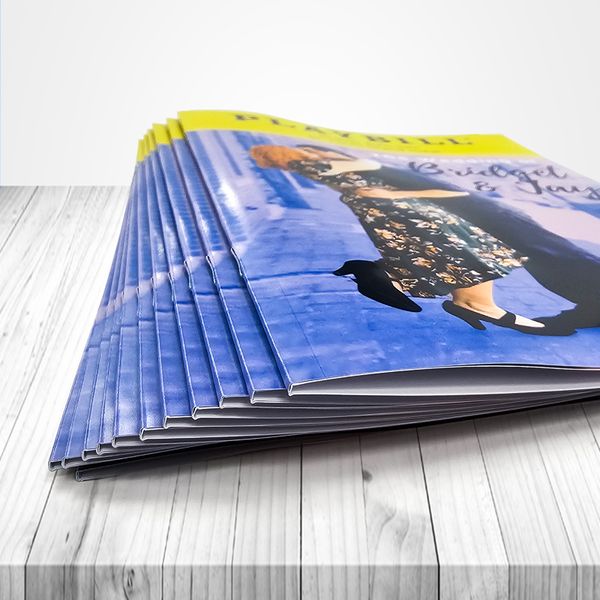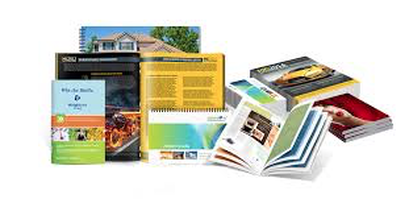The Necessary Overview to Comprehending Booklet Printing Options and Techniques
The process of booklet printing involves multiple factors to consider that can considerably affect the last item. From choosing the proper style and size to understanding the subtleties of binding approaches, each option plays a vital role. In addition, variables such as paper supply and printing methods further affect the efficiency of the booklet. As one browses these alternatives, it ends up being vital to understand just how they adjoin and what that indicates for the overall end result.
Comprehending Brochure Sizes and layouts
When thinking about booklet printing, understanding the numerous styles and dimensions offered is essential for achieving the desired discussion. Booklets can be created in numerous styles, consisting of saddle-stitched, spiral-bound, and perfect-bound, each offering distinct benefits. Common sizes vary from standard letter (8.5 x 11 inches) to smaller sized options like A5 (5.8 x 8.3 inches), enabling flexibility based on web content and target audience.Selecting the ideal dimension can affect both the layout and visitor involvement. Larger dimensions could suit visually driven web content, while smaller sized formats might be extra straightforward and portable. Furthermore, the variety of pages affects the choice of binding method, as thicker brochures might need stronger bindings. Eventually, understanding these aspects enables a more tailored technique, ensuring that the end product aligns with the designated message and visual, boosting the total performance of the communication.
Choosing the Right Paper Stock

Binding Methods: Alternatives and Factors To Consider
When it involves binding approaches for booklets, a number of choices are readily available, each with distinct benefits. Saddle stitch binding uses a cost-effective service for thinner brochures, while excellent binding techniques give an even more polished appearance for thicker magazines. Wire-O binding stands out for its longevity and simplicity of usage, making it excellent for documents that require flexibility.
Saddle Stitch Binding
Saddle stitch binding provides a cost-effective and practical solution for putting together booklets, making it a prominent option among services and publishers. This binding method involves folding sheets of paper in half and stapling them along the fold line, creating a organized and neat appearance. Generally suitable for booklets with a lower web page matter, saddle sewing is optimal for magazines, brochures, and instructional products. The simpleness of this method enables quick manufacturing and is usually preferred for promotional things or short runs. It is vital to note that saddle stitch binding might not be appropriate for thicker booklets, as the back might not hold up under enhanced weight. Overall, it remains a trusted option for several printing jobs.
Perfect Binding Techniques
Perfect binding is an extensively utilized technique that gives a refined and expert surface to pamphlets and magazines. This technique includes gluing the web pages with each other at the spine making use of a strong adhesive, permitting a clean edge and the capacity to hold a larger variety of pages compared to saddle sewing. Perfect binding is especially appropriate for thicker booklets, such as brochures and annual reports, where a durable, level spine is preferred. Additionally, it offers the alternative for a printed cover that can be created to boost aesthetic charm. Nevertheless, considerations such as page matter, paper weight, and the meant use the booklet must be thought about, as they can affect durability and overall high quality.
Wire-O Binding Alternatives
Wire-O binding, recognized for its toughness and versatility, offers an exceptional choice for brochures that need simple web page transforming and a specialist appearance. This binding technique utilizes a series of steel loopholes that hold web pages securely, allowing them to lie flat when open. It is especially ideal for handbooks, discussions, and brochures due to its durable nature. Wire-O binding is readily available in different colors and diameters, suiting various page matters and densities. In addition, it permits the addition of covers and tabs, improving the brochure's overall aesthetic. Factors to consider for Wire-O binding include the choice of cord color, the size of the loopholes, and the level of modification desired, every one of which can greatly affect the final product's look and performance.
Digital vs. Offset Printing: Which Is Best for You?
When selecting a printing technique for booklets, recognizing the differences in between electronic and balance out printing is necessary. Digital printing utilizes contemporary innovation to produce premium prints promptly and economically, making it suitable for short runs or jobs needing fast turn-around times. It permits modification, giving the capability to publish on-demand with minimal waste.In comparison, offset printing is a traditional method that succeeds in creating huge quantities with regular high quality. It entails transferring ink from a plate to a rubber covering, then to the paper, which results in exact information and lively colors. Nevertheless, offset printing normally requires longer configuration times and is more cost-efficient for bigger volumes.Ultimately, the option in between electronic and balance out printing depends on job requirements, budget plan, and preferred amount. For small, time-sensitive jobs, digital may be the finest choice, while balanced why not look here out may be better for larger, top quality productions.

Designing Your Pamphlet: Tips and Finest Practices
When making a brochure, careful interest to format, font style choice, and shade use can greatly boost its efficiency. A well-structured design guides the reader's eye, while proper fonts guarantee readability and convey the wanted tone. In addition, efficient use shade can evoke emotions and highlight vital info, making the general layout more impactful.
Selecting the Right Layout
How can one effectively pick the best layout for a pamphlet? It is essential to review the brochure's objective and target audience. A tidy, arranged layout boosts readability and engagement. Making use of a grid system can help in straightening aspects consistently, developing an expert look. Furthermore, including visual pecking order via varying dimensions and placements of photos and text can direct the viewers's eye and emphasize crucial information. It is likewise essential to leave adequate white room, which avoids overcrowding and enables much better focus. Lastly, testing various layouts through mock-ups can supply insight into exactly how the style executes in real-world scenarios, making sure that the end product satisfies both useful and visual requirements.
Choosing Suitable Font Styles
A well-chosen font can significantly improve the general style of a pamphlet, enhancing the layout and reinforcing the content's message. The choice of font styles ought to consider readability, especially for body text, as it guarantees the information is available to all visitors. Sans-serif font styles are usually preferred for digital formats, while serif typefaces can offer a typical feeling in printed products. It's advisable to restrict font selections to 2 or three to keep aesthetic comprehensibility. In addition, font style size plays a vital role; headings need to be not overwhelming but distinctive, while body message should fit for analysis. When picking fonts, alignment with the brochure's style and target audience is necessary for effective communication and visual allure.
Effective Use Color
Color offers as an effective tool in pamphlet style, shaping perceptions and leading visitor feelings. It can evoke sensations of depend on, excitement, or calmness, depending upon the hues chosen. Developers ought to think about shade theory principles, ensuring that the selected combination straightens with the booklet's message and target audience. For example, utilizing cozy shades like red and orange can create seriousness, while cooler tones like green and blue foster tranquility.Additionally, comparison plays an essential role; complementary colors can improve readability and aesthetic allure. Consistency in shade usage throughout pages further enhances brand identity and cohesion. you can try here Ultimately, effective color implementation not only captures attention but also reinforces the booklet's purpose, making it an important element of successful style.
Completing Touches: Coatings and Special Effects
While many consider the material and format of a pamphlet one of the most essential components, the ending up touches, such as finishings and unique impacts, play a vital role in enhancing its total allure. Coatings can provide protection and durability, ensuring that the pamphlet holds up against deterioration. Matte finishes supply a sophisticated, non-reflective surface area, while glossy finishings can make colors show up more vibrant and attractive. Unique effects, like embossing or aluminum foil stamping, add a tactile measurement that can produce a memorable impression. These methods can highlight specific areas, drawing focus to essential details or producing aesthetic rate of interest. Additionally, UV finish can provide a high-shine finish that raises the overall look.Together, these completing touches not only improve the booklet's visual yet likewise connect expertise and attention to information, ultimately leaving an enduring influence on the reader.
Price Considerations for Brochure Printing
Recognizing the various expense factors to consider for booklet printing is crucial for companies and companies intending to maximize their budgets. Secret variables influencing expenses consist of the selection of binding, ink, and paper techniques. Greater quality products, such as exceptional paper or specialized inks, generally enhance the total expense. Additionally, the size and page matter of the pamphlet play a substantial role; larger brochures need more sources and time to produce.Another crucial consideration is the printing method, whether electronic or countered, as each has its very own rates framework and viability for different amounts. Organizations need to additionally consider layout prices, which can differ based upon intricacy and the usage of expert solutions. Eventually, shipping and handling costs can add to the total, especially for large orders. By assessing these elements, organizations can make informed decisions that align with their financial capabilities while achieving the wanted top quality in their published materials.
Regularly Asked Inquiries
What Are the Ecological Effects of Booklet Printing?
The environmental influences of booklet printing include logging from paper manufacturing, carbon discharges from transportation, and waste generation from discarded products - Booklet Printing. Lasting techniques, such as utilizing recycled paper and environment-friendly inks, can reduce these effects
Just How Can I Make Certain Shade Precision in My Booklet?
To assure color accuracy in a booklet, one ought to utilize adjusted screens, employ specialist color profiles, carry out test prints, and pick high-grade printing solutions that provide shade matching and proofing choices for finest results.
What Is the Regular Turnaround Time for Booklet Printing?
The normal turnaround time for pamphlet printing differs depending upon the intricacy and quantity - Booklet Printing. Generally, it varies redirected here from a few days to 2 weeks, influenced by variables such as printing methods and completing requirements
Are There Minimum Order Quantities for Pamphlet Printing?

Can I Print Booklets in Several Languages?
Printing brochures in numerous languages is feasible. Many printing services provide choices for multilingual or multilingual formats, enabling for reliable interaction. Careful planning guarantees that develop aspects fit various languages without jeopardizing readability or appearances. Additionally, factors such as paper stock and printing techniques further influence the performance of the pamphlet. When considering pamphlet printing, recognizing the numerous layouts and dimensions available is necessary for attaining the preferred presentation. When choosing a printing method for booklets, understanding the differences in between electronic and balance out printing is necessary. Furthermore, the size and page matter of the brochure play a considerable role; bigger pamphlets need more sources and time to produce.Another vital factor to consider is the printing strategy, whether digital or offset, as each has its very own prices structure and viability for various quantities. The ecological effects of booklet printing consist of logging from paper production, carbon emissions from transportation, and waste generation from thrown out materials.
Comments on “How to Design Personalized Campaigns with Variable Data Booklet Printing”